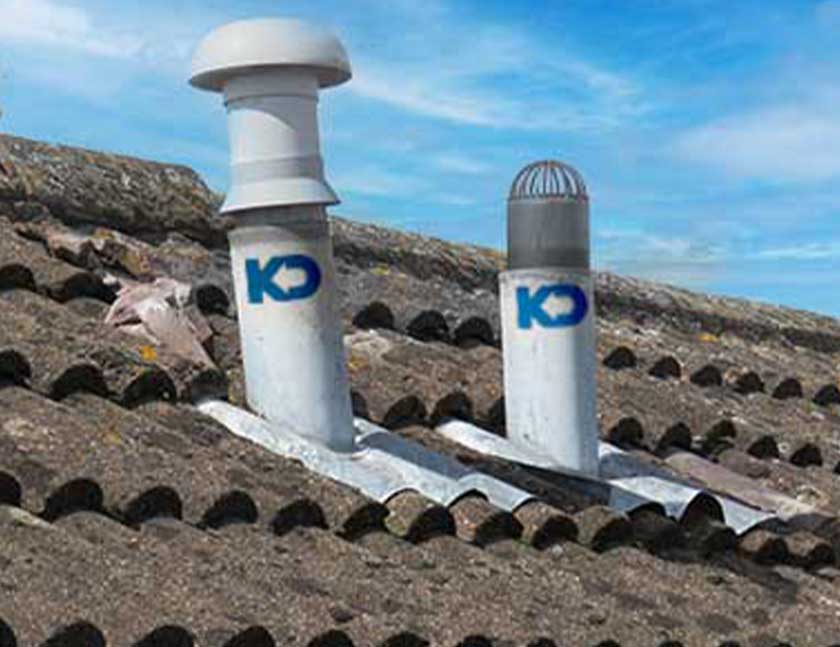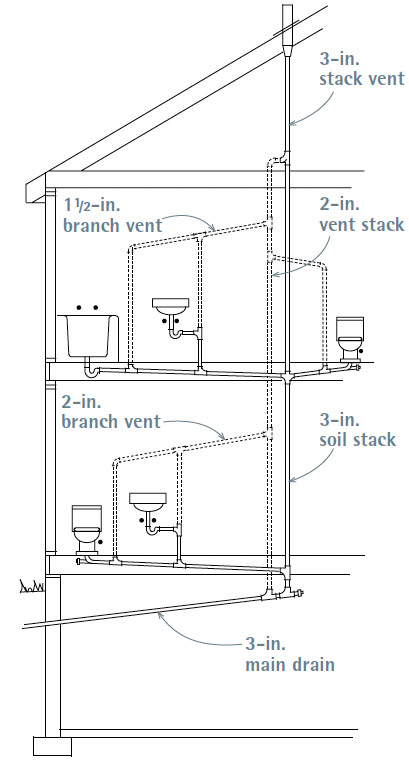How Proper Ventilation is Essential for Plumbing Systems
How Proper Ventilation is Essential for Plumbing Systems
Blog Article
The publisher is making a few good annotation on Essential Plumbing Vent Pipes: Understanding Their Role in general in this article followed below.

Correct ventilation in pipes systems is typically overlooked, yet it is important for keeping the performance and safety of your home's pipes. Ventilation helps manage atmospheric pressure, avoid the buildup of dangerous gases, and make certain the effective removal of waste. In this overview, we will discover the importance of correct pipes ventilation, exactly how it works, and the benefits it offers your plumbing system.
Recognizing Ventilation in Pipes
Ventilation in plumbing describes the network of pipes that enable air to stream through the drain system. These vents serve multiple objectives, including regulating air pressure within the pipes, avoiding sewer gases from entering the home, and aiding in the smooth circulation of wastewater.
Just How Ventilation Works in Pipes Equipments
Atmospheric Pressure Policy
Correct ventilation maintains well balanced air pressure within the pipes system. When water streams via pipes, it displaces air. Without adequate ventilation, this displacement can create negative stress, bring about reduce drains pipes or siphoning of water from traps, which can cause undesirable smells to leak into the home.
Preventing Sewage System Gas Accumulation
One of the most crucial features of pipes vents is to prevent sewage system gases, such as methane and hydrogen sulfide, from accumulating within the home. These gases can position severe wellness dangers and are highly flammable. Vent pipelines allow these gases to leave safely outdoors.
Assisting in Waste Elimination
Air flow assists in the reliable removal of wastewater by stopping airlocks in the water drainage system. When air can move openly via the vents, it permits water and waste to move efficiently through the pipes, decreasing the threat of obstructions and back-ups.
Sorts Of Pipes Vents
Key Heap Vent
The primary pile vent, likewise known as the air vent pile, is the key air vent in a pipes system. It expands from the main drain line up with the roofing system, permitting gases to escape and fresh air to enter the system.
Branch Vent
Branch vents attach to the primary stack air vent and offer individual fixtures, such as sinks, toilets, and showers. These vents make sure that each fixture has sufficient air flow to work correctly.
Air Admittance Shutoff (AAV).
An Air Admission Shutoff (AAV) is a one-way valve that permits air to enter the plumbing system without the requirement for a standard vent pipeline expanding through the roof. AAVs are typically utilized in renovations or locations where setting up a common vent is not practical.
Signs of Poor Ventilation in Pipes.
Slow Draining Fixtures.
If your sinks, tubs, or commodes are draining slowly, it could be a sign of inadequate air flow. Insufficient air circulation can create a vacuum cleaner impact, making it difficult for water to drain pipes appropriately.
Gurgling Sounds.
Gurgling audios coming from drains are often a result of air being drawn via water traps as a result of negative pressure in the pipelines. This is a clear indicator of inadequate air flow.
Unpleasant Smells.
Sewer odors inside your home are a red flag that your pipes system is not effectively ventilated. This could indicate that sewer gases are not being sufficiently vented outside, causing possibly hazardous conditions.
Typical Air Flow Errors.
Insufficient Vent Sizing.
Utilizing undersized air vent pipelines can cause bad air circulation and pressure imbalances in the system. It's necessary to utilize vents that fulfill the details needs of your pipes system.
Improper Vent Placement.
Positioning vents as well much from the fixtures they offer can minimize their performance. Proper positioning makes sure that air can flow easily and efficiently with the system.
Disregarding Code Requirements.
Building ordinance offer details guidelines for pipes air flow. Overlooking these codes can result in a system that stops working to operate correctly and might bring about costly fixings or health hazards.
Benefits of Appropriate Air Flow.
Boosted System Performance.
Properly aerated pipes systems run extra efficiently, with fewer clogs, faster draining, and less strain on the pipes. This efficiency extends the lifespan of the plumbing system.
Improved Air Quality.
By preventing sewage system gases from entering your home, correct air flow adds to much better indoor air high quality, making your living setting healthier and more comfy.
Stopping Water Damages.
Adequate air flow assists stop water from being siphoned out of catches, which can cause sewer gases getting in the home and causing water damages in time.
Actions to Make Sure Proper Air Flow.
Consulting Pipes Codes.
Always get in touch with local plumbing codes when making or customizing your plumbing system. These codes give the needed guidelines for appropriate venting and guarantee your system meets security standards.
Routine Inspection and Upkeep.
Regular assessments can help determine possible air flow issues before they become major issues. Upkeep jobs, such as cleansing vent pipelines and checking for blockages, are important for keeping the system in good working order.
Specialist Installment.
For new installments or major alterations, it's important to hire a professional plumber. They have the know-how to make certain the air flow system is appropriately made and mounted according to code.
Verdict.
Proper air flow is a critical part of any kind of pipes system, guaranteeing that it functions effectively and safely. By recognizing the value of ventilation, acknowledging the signs of bad ventilation, and taking actions to preserve your system, you can protect against expensive concerns and safeguard your home's air top quality.
4 Things You Should Know About Your Plumbing Vents
What Plumbing Vents Are
Also called a vent stack, a plumbing vent is a vertical pipe attached to your drain line that runs through your roof. The plumbing vent pipe, or plumbing air vent, removes gas and odors from your plumbing system and allows fresh air to enter the pipes, helping the water to flow out of the drain pipes.
What Plumbing Vents Do
Plumbing vents have two basic functions. One of which is to allow unpleasant smelling wastewater and sewer gasses to escape your plumbing system instead of entering your home. Plumbing vent pipes are typically located on roofs, away from windows, to ensure the fumes exit the home completely.
The other function of the plumbing vent is to move fresh air into your plumbing system. This helps move water through every plumbing fixture in your house, like toilets and sink drains. Think of the way in which you need to let a little air into the bottle as you pour soda in order to make the drink flow smoothly.
Different Types of Plumbing Vents
True vent: This is the most common vent option. In simplest terms, a true vent is a vertical pipe attached to your drain line that exits through the roof. They often function as the main vent that other fixtures can connect to. Re-vent pipe or auxiliary vent: Attached to the drain line near specific plumbing fixtures, re-vent pipes run up and over to connect to the main vent. Common vent: Two plumbing fixtures installed on opposite sides of a wall are typically tied into the vent stack using something known as a sanitary cross. Wet vent: This venting option operates as a drain pipe and a vent at the same time. Wet vent drainage systems drain water from one fixture while venting the air from another. Although they’ve been used for over 100 years, wet vent systems have only recently been added to the plumbing code in many areas. If you’re planning on installing one in a bathroom remodel, make sure you check your local code prior to construction. Loop vent: For free-standing fixtures like kitchen island sinks, loop vents are ideal. These vent pipes run under the floor, rise from the P-trap, and create a loop inside the cabinet sink. Air admittance valve: An AAV is a one-way mechanical valve typically installed at the site of the plumbing fixture. AAVs allow venting to occur without having to tie into a larger venting system. They’re ideal for venting fixtures where you aren’t able to easily connect to an existing vent system. Common Plumbing Vent Issues
Although vent pipes typically don’t have water flowing through them, they’re still subject to many typical plumbing issues. For example, clogs are one of the most common problems associated with sewer vent pipes. If your vent pipe gets clogged, all of your plumbing fixtures tied into the vent stack will be affected.
A sink with a slow drain that bubbles and gurgles or a strong sewage smell around your toilet are both indicators that your toilet vent pipe is clogged. Because most vent pipes exit through the roof, old leaves, twigs or even a bird’s nest could be clogging the pipe.
Clogs in your vent pipe system cause a buildup of negative pressure, meaning that water won’t be able to flow out of your home very well. It’s similar to putting your finger over the opening of a straw to trap water inside. When you remove your finger, the water is able to flow out of the straw.
If you suspect you have any blockage in your vent, make sure you have a professional come examine the situation. Left unchecked, a blocked air vent can lead to other costly repairs, like leaks and sediment buildup.
Under Pressure
Pipe vents are essential aspects of a home’s plumbing system. Owning a home means learning about all sorts of things you never put much thought into before. But by understanding as much as you can about the important systems of your home, you can keep those budgets intact and those anxiety levels low.
https://www.homeserve.com/en-us/blog/home-improvement/plumbing-vents/

We hope you liked our article about What Are Plumbing Vents and Why Are They Important?. Thank you for finding the time to read our blog post. Sharing is nice. Who knows, you may very well be doing someone a favor. I praise you for being here. Kindly come by our blog back soon.
Book Now! Report this page